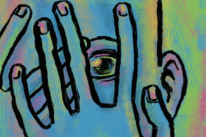
“Where there is anger, there is always pain underneath.” ~ Eckhart Tolle
There I was again, regretting the spiteful words that had cascaded out of my mouth during a heated argument with my partner.
I felt that old familiar feeling, the burning in my solar plexus that bubbled up and erupted like a volcano, spilling out expressions of anger, blame, and criticism.
It had been a rocky few months; my partner was struggling to find consistent work, and our credit card debt was on the rise. Suddenly anger kicked in and I lashed out, accusing him of slacking off and guilting him about me being the only one working.
As the words spilled from my mouth, I knew deep down that what I was saying was hurtful and untrue. I could see that my partner was trying his best, but my anger had taken over, causing suffering that I would later regret.
This was a familiar pattern for me. I’ve frequently reacted emotionally, without understanding why, and caused suffering to myself and my partner and chaos in our relationship. I spent the next few days beating myself up about my reaction and wondering, why do I never seem to learn?
Though I wasn’t self-aware in that particular moment, I know that anger is our body’s response to a perceived threat. It triggers the body’s fight-or-flight response. Our heart rate increases, we become tense, and adrenaline, our stress hormone, releases, so we often spiral into reaction mode in order to protect ourselves.
Although we tend to view anger in a negative light, I have come to learn that anger itself is a valid emotion, just like happiness or sadness. And it does, in fact, serve a valid purpose. Anger sends a message to our body and brain that something painful within us has been triggered and is asking to be acknowledged. In many cases, it signals that there is something much deeper, a wound that brings up vulnerability and pain.
We need to take a step back, go inward, and begin to explore where the triggers for these behaviors and reactions stem from.
Growing up, we are conditioned to behave in certain ways based on our environment and circumstances.
As children, certain behaviors are ingrained in us from our family and peers. We learn to mimic those around us—for example, how they communicate and respond to one another—and over time we implement those behaviors as our own. Not only do we mimic their behaviors, we also take on their fears and beliefs. Then, when something triggers these fears and beliefs, we react in order to protect ourselves.
When I began delving into the root cause of my reactions around finances, it surprised me to learn of the deep conditioning I had been living through my parents’ stories about money.
When I was growing up, my parents often struggled to make ends meet and were under a lot of financial pressure.
They did their best to protect my brother and me, attempting to not let their financial stress impact our lives. But the truth is, we cannot help but be conditioned by our environment. Unconsciously, we pick up on our parents’ energy and develop certain coping mechanisms and patterns that become deeply ingrained as we continue to carry them through life.
When I was able to look past the anger around my own financial insecurities, I discovered deep fears and vulnerability.
I was living with the painful belief that my partner and I would always struggle financially, that we would not be able to get by, and that we would experience the same hardships that my parents did. This story was interwoven through my family, going back even further to when my grandparents and great-grandparents lived through extreme poverty in Eastern Europe. This conditioning was so much deeper than I could ever imagine.
Identifying where these beliefs stemmed from gave me the insight to take a look at the bigger picture and understand the painful stories I had taken on as my own. It allowed me to take responsibility for my own destructive patterns. I was beginning to see how my reactions were triggered by an unconscious fear out of a need for survival.
Your triggers might be completely different, and they may pertain more to pain from your childhood than inherited beliefs and fears. For example, if your parents regularly shamed you for mistakes when you were a kid, you might react defensively whenever someone points out an area where you have room for improvement. Or, if you felt ignored growing up, you may have a knee-jerk reaction whenever someone can’t spend time with you.
The problem is, our conditioning is so deeply ingrained within us that we are not even aware of our reactions most of the time. They just become an automatic response. We cannot always recognize that we are simply replaying old patterns over and over again. We tend to blame external circumstances or others for causing our suffering.
We play the victim without realizing that we ourselves are the ones causing the drama and the pain around us.
I was at a point in my life where I needed to make a choice: continue living my old patterns, which were causing negative reactions and suffering, or take responsibility and ask myself, “What is underneath my anger? What is the root cause of my suffering?”
When you look back to your past to understand your triggers, it will feel uncomfortable and challenging at times. But when you are able to sit with your emotions and delve a little deeper, you start breaking through your conditioned patterns and behaviors and set yourself free.
The only way forward is by choosing to do the work to get there.
It’s important to understand that our conditioning came from many years of reinforcing these old beliefs, so it is no surprise that change won’t happen overnight. We need be kind to ourselves through this process instead of judging ourselves and our mistakes, or beating ourselves up if we fall along the way. Each step we take brings us closer to breaking old patterns and forming new, positive ones.
So where to begin?
These are some techniques that have helped me on my journey toward breaking old patterns.
1. Don’t react; pause.
When you experience that old familiar feeling of anger or frustration bubbling up inside you, don’t react. Instead of erupting like a volcano pouring out hurtful words and reactions, try pausing for a moment.
Take some space to reflect and name the emotions that surface—maybe fear, resentment, shame, or desperation—and explore underneath the anger. Ask yourself, “What was triggered for me at this time?”
Don’t try to overanalyze the situation; just sit with the emotions and see what arises. Do you feel vulnerable or powerless, or a sense of sadness, betrayal, or fear?
2. How does it feel in your body?
Ask yourself, “Where do these emotions sit in my body? What are the sensations they present?”
Once again, don’t overanalyze; just sit with the bodily sensations. Maybe you feel heat in your solar plexus or an aching in your heart. These sensations are asking for your acknowledgment; send them love.
3. Identify your go-to response.
Ask yourself, “How would I usually respond in this situation?” Maybe you would react by shouting, trying to push someone’s buttons, or becoming defensive.
Take the time to recognize your usual response and sit with it for a moment. Identify how this response may cause pain and suffering to yourself and others.
4. Reflect.
Ask yourself, “Am I acting from a place of love and kindness?”
By asking yourself this, you take the focus off blaming others or the situation, take responsibility for your own actions, and reclaim your personal power.
By taking responsibility, you are then able to consciously choose how you respond to any given situation. Remember, you don’t have control over how other people respond, but you do have 100% control over your response and if it causes joy or suffering.
5. Practice awareness.
Remember you are acting out a conditioned behavior; it is your automatic response. When you practice awareness by identifying conditioned behaviors, you begin to take the power away from the old patterns and create space to form new positive ones.
It’s like rewriting your story. You have the power to recreate your story and transform old patterns into ones that serve you and align with your true essence and purpose in life.
6. Be kind to yourself.
Your conditioned responses and behaviors are your defense mechanisms, the coping strategies you learned to protect yourself in the world.
Acknowledge that you’ve always done your best based on what you learned growing up, and you’re now doing your best to change. If you struggle, treat yourself with kindness and compassion. It’s okay to make mistakes; don’t beat yourself up. Remember, every step you take brings you closer to personal freedom.
—
You may find it helpful to keep a journal to reflect on the above points when your old destructive patterns emerge. Journaling has been my savior during this process.
These techniques empowered me to recognize conditioned patterns and behaviors that were holding me back. They’ve also enabled me to communicate and connect with others positively and effectively. It’s not always easy to identify when you are acting out an old behavior, but the more you practice awareness when situations trigger you, the easier it will become to break these old patterns.
About Erin Grace
Erin Grace is a writer, Reiki Master, and founder of Story Bones, a self-healing platform inspired by her journey of self-discovery whilst battling mental health issues. Erin empowers individuals to transform their life, through challenging self-limiting beliefs and identifying how the stories of our past, shape our lives today. Get the FREE guide - Master your Story, Transform your Life.
- Web |
- More Posts













 Though I run this site, it is not mine. It's ours. It's not about me. It's about us. Your stories and your wisdom are just as meaningful as mine.
Though I run this site, it is not mine. It's ours. It's not about me. It's about us. Your stories and your wisdom are just as meaningful as mine.